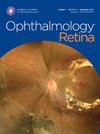Endophthalmitis in Eyes Treated with the Port Delivery System with Ranibizumab
IF 4.4
Q1 OPHTHALMOLOGY
引用次数: 0
Abstract
Purpose
The Port Delivery System with ranibizumab (PDS) is approved in the United States for neovascular age-related macular degeneration. The United States Prescribing Information has a Boxed Warning for endophthalmitis and reports the incidence rate in patients developing endophthalmitis after receiving the PDS compared with monthly intravitreal ranibizumab. Endophthalmitis cases noted in the Boxed Warning, treatment outcomes, potential contributing factors, and potential mitigations are summarized.
Design
Retrospective review of endophthalmitis cases in PDS-treated patients in the phase II Ladder (NCT02510794) and phase III Archway (NCT03677934) and Portal (NCT03683251) trials.
Participants
Endophthalmitis cases in the pooled all-PDS safety population (N = 555) including PDS patients in Ladder, Archway, or Portal.
Methods
Ladder patients received PDS (10, 40, or 100 mg/ml) with pro re nata refill-exchanges. Archway patients received PDS 100 mg/ml with fixed refill-exchanges every 24 weeks (PDS Q24W). Portal patients received PDS Q24W from day 1.
Main Outcome Measures
Clinical features, management, and visual outcomes were summarized. Cases were summarized by date of PDS implant and/or refill, other prior invasive procedures/refills, and preceding/concurrent conjunctival complications.
Results
Twelve endophthalmitis events were reported in 11 patients (11/555 [2.0%]) through March 12, 2021. All were cultured (3 were culture positive) and treated with intravitreal antibiotics. Two cases (2/555 [0.4%]) occurred in the immediate postoperative period (days 5 and 6). Nine cases occurred later (day range: 57–853), including 4 before the first refill-exchange (day range: 57–161). Five patients received between 1 and 11 refill-exchanges before the event (onset: 6–168 days after last refill-exchange). Seven cases (7/11 [63.6%]) had preceding/concurrent conjunctival complications. At last follow-up, 7 patients recovered vision to study baseline levels or ≥20/40; 4 patients experienced vision loss of ≥15 ETDRS letters.
Conclusions
Endophthalmitis is a serious complication that can endanger vision after any ocular procedure, including PDS implantation. Most, but not all, of this limited series of endophthalmitis cases were late onset, associated with conjunctival breach, and recovered vision with treatment. Meticulous attention to PDS surgical techniques with vigilant monitoring of conjunctiva during follow-up may minimize risk of endophthalmitis. Prompt treatment is critical for optimizing patient outcomes.
Financial Disclosure(s)
Proprietary or commercial disclosure may be found in the Footnotes and Disclosures at the end of this article.
使用雷珠单抗门给药系统治疗的眼内炎:临床试验开发期间的病例摘要。
目的:含雷尼珠单抗的导入系统(PDS)已在美国获批用于治疗新生血管性老年黄斑变性。美国《处方信息》中有一项眼内炎的 "盒装警告",并报告了与每月使用玻璃体内雷尼珠单抗相比,患者在接受 PDS 治疗后眼内炎的发病率。本文总结了盒装警告中提到的眼内炎病例、治疗结果、潜在诱因以及可能的缓解措施:回顾性分析2期Ladder(NCT02510794)、3期Archway(NCT03677934)和Portal(NCT03683251)试验中PDS治疗患者的眼内炎病例:眼内炎病例,包括 Ladder、Archway 或 Portal 试验中的 PDS 患者:Ladder患者接受PDS(10、40或100毫克/毫升),并按比例重新充填换药。Archway 患者接受 100 毫克/毫升的 PDS,每 24 周进行一次固定的再充填-更换(PDS Q24W)。门户型患者从第 1 天开始接受 PDS Q24W:总结临床特征、管理和视觉结果。根据 PDS 植入和/或重新填充的日期、之前的其他侵入性手术/重新填充以及之前/并发的结膜并发症对病例进行总结:结果:截至 2021 年 3 月 12 日,11 名患者(11/555 [2.0%])共报告了 12 例眼内炎事件。所有病例都进行了培养(3 例培养呈阳性),并接受了玻璃体内抗生素治疗。两例(2/555 [0.4%])发生在术后初期(第 5 天和第 6 天)。九例发生在术后(天数范围:57-853 天),其中四例发生在第一次更换笔芯之前(天数范围:57-161 天)。五名患者在事件发生前更换了 1-11 次补充液(发病时间:最后一次补充液更换后 6-168 天)。有 7 例患者(7/11 [63.6%])之前或同时出现结膜并发症。最后一次随访时,7 名患者的视力恢复到研究基线水平或≥ 20/40;4 名患者的视力下降≥ 15 个 ETDRS 字母:眼内炎是一种严重的并发症,可危及任何眼科手术(包括 PDS 植入术)后的视力。这一系列有限的眼内炎病例表明,大多数(但不是全部)病例发病较晚,伴有结膜破损,经治疗后视力得以恢复。在随访过程中,严格遵守 PDS 手术技术并对结膜进行警惕性监测,可将眼内炎的风险降至最低。及时治疗是优化患者预后的关键。
本文章由计算机程序翻译,如有差异,请以英文原文为准。
求助全文
约1分钟内获得全文
求助全文

 求助内容:
求助内容: 应助结果提醒方式:
应助结果提醒方式:


